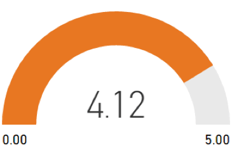One year ago, we began a project to get unbiased and anonymous feedback from our clients about their opportunities for growth and what holds them back.
250 CEOs, CFOs, HR Directors, and Safety Managers from 50 different companies responded to questions on the topics of Leadership, People, Brand, Risk & Employee Benefits. This is what they said.
LEADERSHIP

Almost 80% of respondents stated that they were optimistic about the future of their company. There is a lot of opportunity out there for companies with the capabilities to act on it.
- There is a consistent concern that companies are taking on too much, but at the same time they are excited about the opportunity for new business growth. In this period of rapid expansion, it is more important than ever to put controls in place to ensure that growth doesn't compromise culture or safety.
- Most companies are facing a generational transition of the leadership team. At the same time, they view their current leadership team as one of their greatest strengths. In spite of this obvious gap, leadership succession planning and development is being overlooked by most companies.
- Almost all business leaders recognize that it’s incredibly difficult to find top talent. Most of these companies believe that their current employees are one of their biggest assets, so they are investing heavily in building cultures that attract great people. It's more important than ever to be able to deliver a career that aligns with what the next generation is looking for: to make a difference.
PEOPLE
Half of respondents said that their talent is above average, but only 14% rated their talent as top notch. In an economy that rewards innovation and adaptability, top notch talent is going to be a necessity to thrive in the hyper-competitive marketplace of the future.
Almost 70% of companies believe that they could be growing faster if they had more talented people on their team. Although this isn’t surprising, what is surprising is that most companies aren’t being very proactive about fixing the problem.
The fact that only half of all companies are successfully attracting young talent is alarming. The need to replace existing leadership teams with strong, younger employees was identified as one of the biggest dangers facing companies. (For the purposes of this survey, we considered 'young' to be 35 years old or younger.)
It's a job-seeker's economy. With virtually all industries growing and unemployment at an all-time low, job-seekers are choosing where to work. To land the best people, companies need to be far more strategic in their recruiting efforts.
70% of companies said that they are losing good people. Why is this happening? Pay is perceived to be the biggest reason good employees are leaving. However, a close second is that the best people think that there are better opportunities elsewhere. To keep our best people, we need to make sure we are continuously offering them opportunities to challenge themselves and grow.
BRAND
Differentiators are supposed to make your company stand out from the competition. However, the most common responses to the question “What makes your company different?” were exactly the same. The most prevalent answers were “treat you like family”, “great customer relationships” and “quality service”. The obvious conclusion here is that if we’re all saying the same things, they don’t make us stand out at all. Your company needs to stand for something. It's time to figure out what that is.
RISK & EMPLOYEE BENEFITS
65% of respondents rated their safety culture as strong. A strong safety culture is the foundation for reducing your cost of risk and breaking free from insurance dependency. Without this, you'll be stuck paying for the bad decisions that your people make through higher insurance costs.
There is a clear need for a strong next generation of leaders. Given this, it is surprising that most companies aren’t formally training and developing their current employees. As we’ve already stated, most companies believe they have strong talent already on their team. It’s time to help these top people get better.
As the cost of providing employee benefits increases, the gap between what companies are spending and employee perception of this cost is getting wider. To get the most bang for your buck, it pays to spend more time communicating the value of your employee benefits. How do your employee benefits compare to industry averages? If your employees don't know this, they probably are going to undervalue what you're offering.
Nearly all companies share this concern. The current trend is eating away at profits. It's simply not sustainable. The best companies are implementing multi-year strategies to take back control and gain a competitive advantage. These strategies almost always involve more company ownership of risk through financing mechanisms such as self-funding or group captives.
WHAT IT ALL MEANS
Our main conclusion from these findings is this:
Most companies face a very similar set of challenges. What will distinguish the best companies from average companies is how successfully they tackle them.
Leaders need to be developing and driving a multi-year strategy focused on seizing opportunities and mitigating risks. And you, as the leader of your company, need to be the one to drive the strategy forward.
We’ve seen great strategies get delegated. And we’ve seen hollow ‘strategies’ created simply to ‘check the box’. These shortcut attempts always fail.
When it comes to something as important as your business's future, unfortunately there are no shortcuts. Let's get to work.
.png?width=69&height=53&name=Acrisure%20Logo%20(White%20Horizontal).png)

